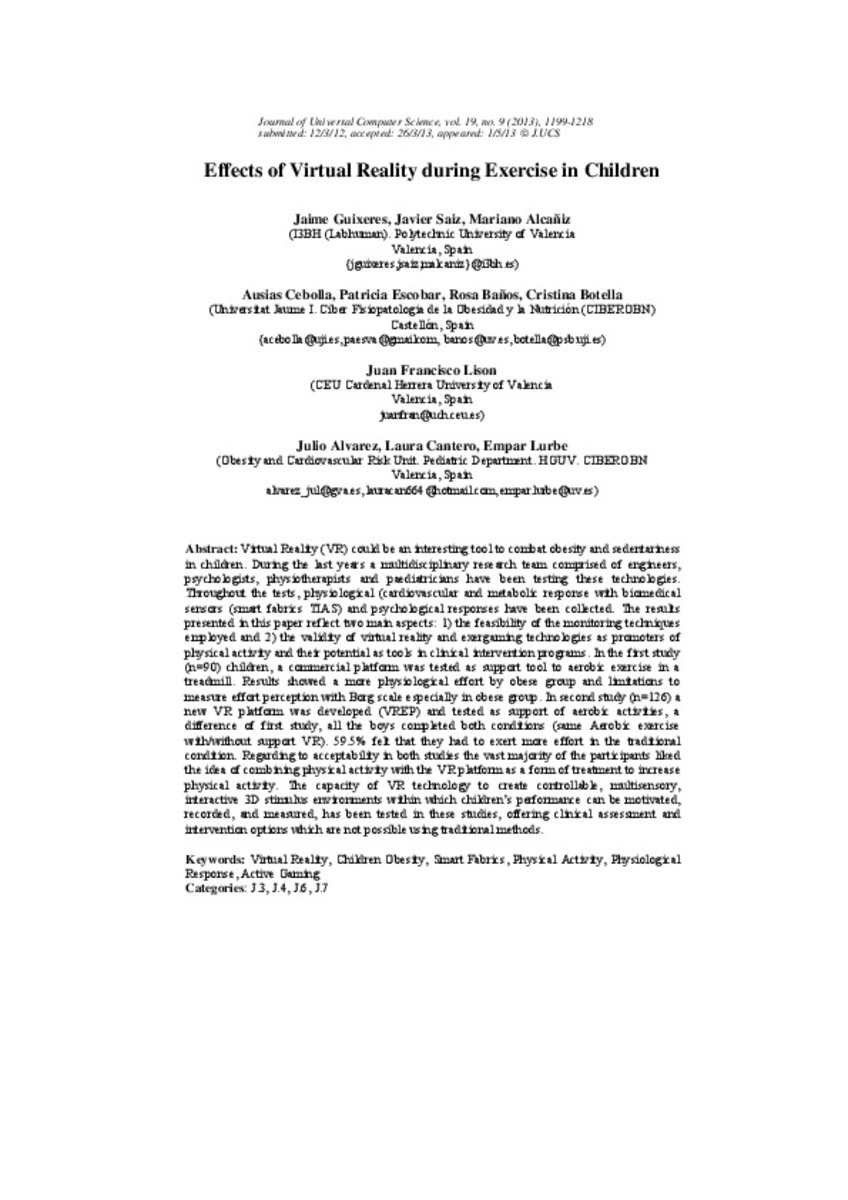Mostrar el registro sencillo del ítem
Effects of Virtual Reality during Exercise in Children
| dc.contributor.author | Guixeres, Jaime | |
| dc.contributor.author | Sáiz, Javier | |
| dc.contributor.author | Alcañiz, Mariano | |
| dc.contributor.author | Cebolla Marti, Ausias | |
| dc.contributor.author | Escobar, Patricia | |
| dc.contributor.author | Baños, Rosa Maria | |
| dc.contributor.author | Botella, Cristina | |
| dc.contributor.author | Lison, Juan Francisco | |
| dc.contributor.author | Álvarez Pitti, Julio | |
| dc.contributor.author | Cantero, Laura | |
| dc.contributor.author | Lurbe Ferrer, Empar | |
| dc.date.accessioned | 2014-06-10T12:26:47Z | |
| dc.date.available | 2014-06-10T12:26:47Z | |
| dc.date.issued | 2013 | |
| dc.identifier.citation | GUIXERES, Jaime, et al. Effects of Virtual Reality during Exercise in Children. Journal of Universal Computer Science, 2013, vol. 19, no 9, p. 1199-1218. | ca_CA |
| dc.identifier.issn | 0948-695X | |
| dc.identifier.issn | 0948-6968 | |
| dc.identifier.uri | http://hdl.handle.net/10234/94545 | |
| dc.description.abstract | Virtual Reality (VR) could be an interesting tool to combat obesity and sedentariness in children. During the last years a multidisciplinary research team comprised of engineers, psychologists, physiotherapists and paediatricians have been testing these technologies. Throughout the tests, physiological (cardiovascular and metabolic response with biomedical sensors (smart fabrics TIAS) and psychological responses have been collected. The results presented in this paper reflect two main aspects: 1) the feasibility of the monitoring techniques employed and 2) the validity of virtual reality and exergaming technologies as promoters of physical activity and their potential as tools in clinical intervention programs. In the first study (n=90) children, a commercial platform was tested as support tool to aerobic exercise in a treadmill. Results showed a more physiological effort by obese group and limitations to measure effort perception with Borg scale especially in obese group. In second study (n=126) a new VR platform was developed (VREP) and tested as support of aerobic activities, a difference of first study, all the boys completed both conditions (same Aerobic exercise with/without support VR). 59.5% felt that they had to exert more effort in the traditional condition. Regarding to acceptability in both studies the vast majority of the participants liked the idea of combining physical activity with the VR platform as a form of treatment to increase physical activity. The capacity of VR technology to create controllable, multisensory, interactive 3D stimulus environments within which children’s performance can be motivated, recorded, and measured, has been tested in these studies, offering clinical assessment and intervention options which are not possible using traditional methods. | ca_CA |
| dc.format.extent | 19 p. | ca_CA |
| dc.format.mimetype | application/pdf | ca_CA |
| dc.language.iso | eng | ca_CA |
| dc.publisher | Graz University of Technology, Institut für Informationssysteme und Computer Medien | ca_CA |
| dc.relation.isPartOf | Journal of Universal Computer Science (2013) vol. 19, no 9 | ca_CA |
| dc.rights | © Graz University of Technology, Institut für Informationssysteme und Computer Medien | ca_CA |
| dc.rights.uri | http://rightsstatements.org/vocab/InC/1.0/ | * |
| dc.subject | Virtual Reality | ca_CA |
| dc.subject | Children Obesity | ca_CA |
| dc.subject | Smart Fabrics | ca_CA |
| dc.subject | Physical Activity | ca_CA |
| dc.subject | Physiological Response | ca_CA |
| dc.subject | Active Gaming | ca_CA |
| dc.title | Effects of Virtual Reality during Exercise in Children | ca_CA |
| dc.type | info:eu-repo/semantics/article | ca_CA |
| dc.rights.accessRights | info:eu-repo/semantics/openAccess | ca_CA |
| dc.relation.publisherVersion | http://www.jucs.org/jucs_19_9/effects_of_virtual_reality/jucs_19_09_1199_1218_guixeres.pdf | ca_CA |
| dc.type.version | info:eu-repo/semantics/publishedVersion | ca_CA |
Ficheros en el ítem
Este ítem aparece en la(s) siguiente(s) colección(ones)
-
PSB_Articles [1330]
Articles de publicacions periòdiques







